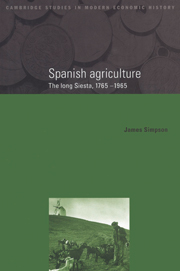Book contents
- Frontmatter
- Contents
- List of illustrations
- List of tables
- Acknowledgements
- Note on the regional division of Spain
- Abbreviations and conventions
- Introduction
- Part I The relative backwardness of Spanish agriculture
- Part II Traditional technologies and market opportunities, 1765–1880
- Part III The limits to technical change, 1880–1936
- Part IV Markets and institutions, 1880–1936
- 8 The growth of the home market and agricultural specialisation
- 9 Agricultural exports and the international economy
- 10 The political economy of Spanish agriculture
- Part V The State and the end of traditional agriculture
- Conclusion
- Appendix Estimates of agricultural output and consumption in nineteenth-century Spain
- Bibliography
- Index
8 - The growth of the home market and agricultural specialisation
Published online by Cambridge University Press: 04 December 2009
- Frontmatter
- Contents
- List of illustrations
- List of tables
- Acknowledgements
- Note on the regional division of Spain
- Abbreviations and conventions
- Introduction
- Part I The relative backwardness of Spanish agriculture
- Part II Traditional technologies and market opportunities, 1765–1880
- Part III The limits to technical change, 1880–1936
- Part IV Markets and institutions, 1880–1936
- 8 The growth of the home market and agricultural specialisation
- 9 Agricultural exports and the international economy
- 10 The political economy of Spanish agriculture
- Part V The State and the end of traditional agriculture
- Conclusion
- Appendix Estimates of agricultural output and consumption in nineteenth-century Spain
- Bibliography
- Index
Summary
It is thus that through the greater part of Europe the commerce and manufactures of cities, instead of being the effect, have been the cause and occasion of the improvement and cultivation of the country.
The role of cities in providing a stimulus to change in the agricultural sector has received much attention from historians and economists in recent years. If towns required labour productivity in agriculture to increase, so that ‘a rising proportion of the workforce can find employment in secondary and tertiary activities without prejudicing the supply of food or raising its price inordinately’, agriculture was equally dependent on urban demand to permit greater specialisation, economies of scale, and to absorb surplus labour. Thus, as students of the First Agricultural Revolution have noted, the introduction of mixed farming in northern Europe was closely linked to the growing urban demand for meat and dairy produce, which encouraged a reallocation of resources towards livestock. In this chapter I examine the interconnection between the rural and urban economies and argue that if there were obstacles to increasing labour productivity in Spanish agriculture, urban demand was also a weak stimulant to agricultural change.
In the first section I show that despite important changes in per capita income, diets were slow to diversify in the years prior to the Civil War, with consumption of basic staples accounting for both a large part of expenditure and calorie intake, in contrast to the low consumption of superior foods, such as meat or dairy produce.
- Type
- Chapter
- Information
- Spanish AgricultureThe Long Siesta, 1765–1965, pp. 177 - 202Publisher: Cambridge University PressPrint publication year: 1996



